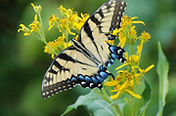West Virginia white (Pieris virginiensis)
CONFIRMATION STATUS: Confirmed.
FAMILY: Whites and Sulphurs (Pieridae)
SUBFAMILY: Whites (Pierinae)
IDENTIFICATION: Wings are translucent, whitish, with no yellowish tint
underneath. Underside of hindwings with blurry brown or pale gray
scaling along veins.
LIFE HISTORY: Males patrol slowly to locate females. Eggs are laid singly
on undersides of host plant leaves. Chrysalids hibernate on stems or
plant litter under the plant.
FLIGHT: In the North, one flight in May; in the South, one flight from
April-May.
WING SPAN: 1 3/4 - 2 1/8 inches (4.5 - 5.3 cm).
CATERPILLAR HOSTS: Toothworts (Dentaria diphylla and Dentaria
laciniata) in the mustard (Brassicaceae) family.
ADULT FOOD: Flower nectar from toothworts, spring beauty, violets, and
other plants.
HABITAT: Moist deciduous woodlands or mixed woods.
RANGE: Northern Great Lakes states and from New England southwest
along the Appalachians to north Georgia and northeast Alabama.
CONSERVATION: A species of native, relatively undisturbed habitats.
Declining due to timbering, development, and spread of garlic mustard
(Alliaria officinalis).
NATURESERVE GLOBAL STATUS: G4 - Apparently secure globally, though
it might be quite rare in parts of its range, especially at the periphery.
MANAGEMENT NEEDS: Control spread of garlic mustard. Ensure
timbering intensity allows recovery of sufficient habitats on local scale.
SKY MEADOWS OCCURRENCE:
Note: Due to seasonal conditions in this region, occurrence may vary from
year to year. The designation of occurrence may range over two or more
categories and may vary even during a single season.
Key to Checklist
A Abundant: Easy to see very large numbers of individuals in appropriate habitat
at proper time of year.
C Common: Usually each to see good numbers of individuals in appropriate habitat
at proper time of year.
U Uncommon: Sometimes found in appropriate habitat and proper time of year,
usually in low numbers.
O Occasional: Found in appropriate habitat perhaps only a few times a year, usually
in low numbers.
R Rare: Small chance of being found, even in appropriate habitat at proper time of
year. There are few individuals and may not be present every year.
X Extirpated: Formerly present, no longer occurs in Sky Meadows Park.
January
February
March
April
May
June
July
August
September
October
November
December

Park Activities
Calendar of Events
Volunteer Programs
Sky Meadows Park
Location
Geography
Habitats
Trails
Visiting Park
Crooked Run Valley
Special Projects

